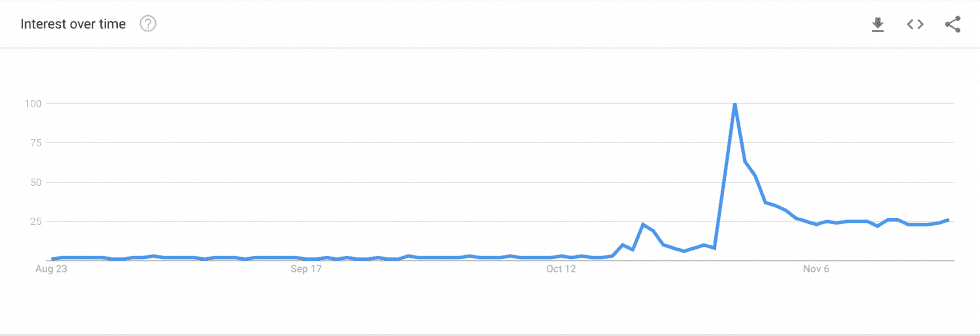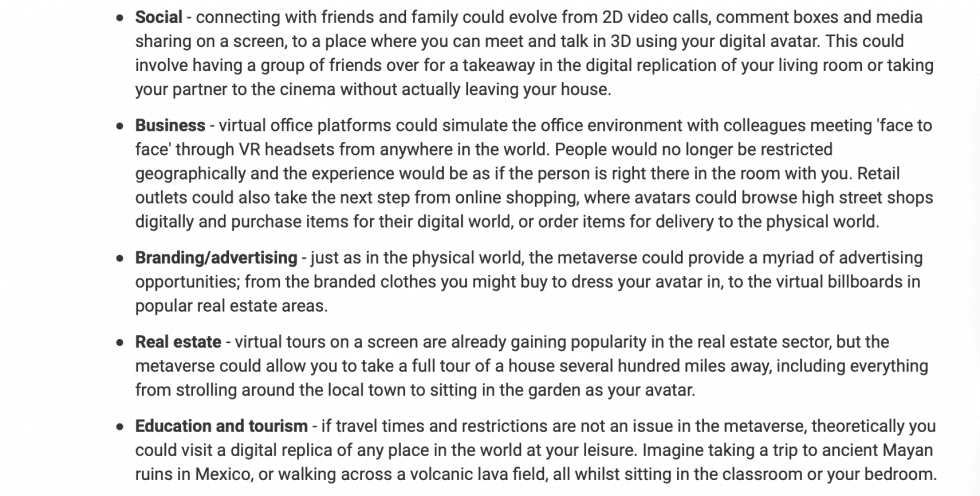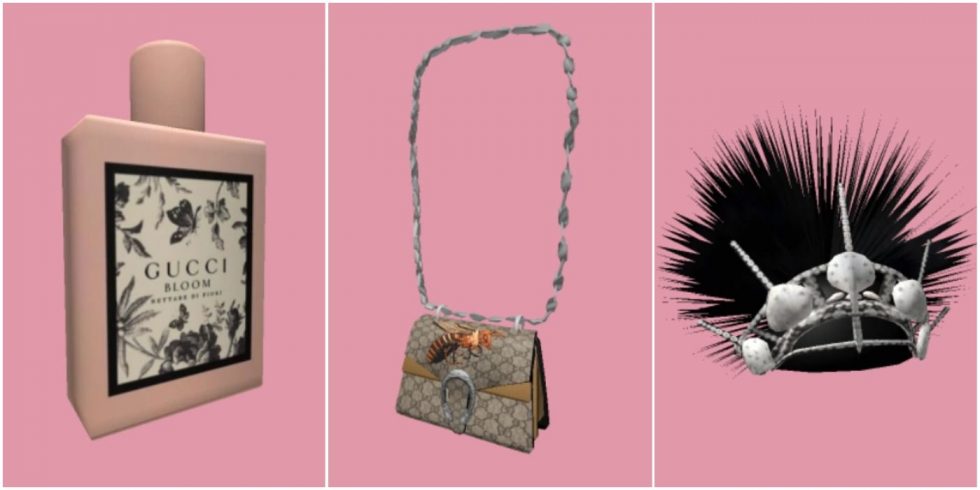Deep Dives
On late November, Tokens.com made headlines thanks to a large-scale real estate purchase. The crypto investment company’s Metaverse Group subsidiary paid $2.4 million – in crypto – in what is being called one of “the largest ever land acquisitions.” The important caveat is that the land exists exclusively “in the metaverse.” Specifically, Metaverse Group splashed out more than $2 million for a 6,090 square feet virtual parcel on Decentraland. Located in the Fashion Street District of the Ethereum-powered decentralized 3D virtual reality platform, Toronto-based Tokens.com revealed that the real estate will be used “by fashion brands to advertise, host fashion shows, and have e-commerce storefronts.”
The Metaverse Group news is the latest development to come in the swiftly-growing metaverse – which combines immersive virtual reality, massive multi-player online gaming platforms, and various other facets of the web – and it comes as consumers, brands (including fashion and luxury ones), and crypto firms continue to make inroads into the space.
In the past several weeks, alone, Nike announced a partnership with Roblox to enable its fans to “connect, create, share experiences, and compete” in a “bespoke” virtual world called Nikeland. Adidas teased its own impending venture into the metaverse – or the “adiVerse” – with platform The Sandbox. London-based brand Stefan Cooke teamed up with EA to bring menswear to The Sims universe, and Moncler debuted a collaboration with Epic Games in a tie-up that sees its collaboration with 1017 Alyx 9SM enter into the Fortnite virtual world.
Even vacuum-maker Dyson wants in, opening a virtual-reality showroom, which it says will eventually incorporate fully integrated e-commerce and customer service capabilities.

A peek inside Decentraland
All the while, Winklevoss-led company Gemini has raised $400 million to build a decentralized metaverse, i.e., “one where we believe there’s greater choice, independence and opportunity, and there is technology that protects the rights and dignity of individuals,” Cameron Winklevoss said recently. And Niantic, the augmented reality platform behind Pokémon GO, announced this week that it closed a $300 million round to fund its plan to build a “real-world metaverse.”
Of course, none of these efforts have topped the announcement that Facebook, Inc. made late last month, when it revealed that it would rebrand to Meta, a move that swiftly resulted in widespread interest in the metaverse. In addition to a spike in Google searches for “metaverse,” the news prompted the registration of “an unprecedented number of new domain names,” according to Crowell & Moring LLP’s Alexander Urbelis and Howard Michael.
Between October 29 and November 2, nearly 50,000 new domain names containing the word “meta” were acquired. “A significant number of these newly-registered domains incorporate the names of other companies and organizations, or well-known trademarks, e.g., meta-[company name].com or meta[trademark].com,” which Urbelis and Michael say is significant from a trademark and “brand strength” point of view.

Google searches for “metaverse” over the past 90 days
Speaking of Meta-related trademarks, Facebook, Inc.’s adoption of its new name is striking in a branding sense because while the metaverse is not new, Meta very well may be the primary point of introduction to the metaverse for large swathes of the population over the age of 16. Most younger consumers will already be well-acquired with the space thanks to platforms like Roblox, where the majority of the 43 million daily active users are under 16.
With this in mind, Meta – whose metaverse division is slated to spend at least $10 billion this year creating AR and VR hardware, software, and content, and even more in the years to come – will almost certainly benefit from a brand-building perspective. Specifically, it will likely amass a bigger stake in the space in the minds of consumers thanks to the potential confusion that is already underway about what the metaverse is and whether it is exclusive to Meta. (Hint: it is not.) And there is plenty of confusion at play. As CNBC reported this past weekend, for instance, a slew of major “execs seemed confused about the metaverse on Q3 earnings calls.”
The chance that consumers will associate all things (or at least many things) metaverse with the company formerly known as FB, Inc. – thanks to the name and the timing of its rebrand – is an interesting potential outcome from a branding and market ownership perspective, and one that provides some strategy takeaways for other brands.
Zooming out to what the metaverse looks like on a more macro level, the space is being valued at much more than $50 billion. In a note last week, Morgan Stanley put a $50 billion valuation on the opportunities for fashion and luxury goods brands, alone, in the metaverse, noting that as of now, “revenue streams from digital mediums for luxury brands are negligible, [but] we think this is about to change.” The bank’s analysts “expect the whole [fashion/luxury] sector to benefit from the advent of the metaverse,” but said that they see “soft luxury brands (ready-to-wear, leather goods, shoes, etc.) as particularly well positioned.”
Part of the draw here is that the metaverse will provide brands in fashion and beyond with new revenue streams. It will also give them the ability to “bridge the gap” between virtual and physical realities, such as immersive shopping experiences or large-scale virtual events, as Meta ad exec Nicola Mendelsohn put it recently. Beyond that, the metaverse is also being touted as a way for companies to reduce waste and increase operational efficiencies. According to Jensen Huang, CEO of chip-behemoth Nvidia, running simulations in the metaverse can deliver real-world benefits to corporations, including the ability to save “hopefully hundreds and hundreds and hundreds of billions of dollars.”
There are countless other uses, of course, some of which have been set out by Gowling WLG’s David Brennan, Sushil Kuner, and Danielle Hudspith …

Regardless of the individual opportunities that come with the development of the metaverse, ultimately, the phenomenon is expected to take the form of a series of interoperable, decentralized worlds which users can seamlessly navigate. However, as of now, the reality looks more like “walled gardens” owned and operated by single entities. With this in mind, brands that are looking to experiment in the metaverse now are faced with an array of issues, including how to manage their intellectual property (and that of others) when dealing in these distinct metaverses – from Roblox to Fortnite and beyond.
“It is crucial to establish clear intellectual property licensing arrangements with each metaverse platform provider,” according to DLA Piper’s Anthony Lloyd, Jessie Buchan, and Edmond Lau. As with any IP license, they note that “typical terms, such as duration, territory, and royalty rates are important,” but particular attention should be paid to the scope of a license. “As part of any collaboration, a metaverse platform may combine their own IP with another brand’s IP when creating content,” per Lloyd, Buchan, and Lau. “Absent mutually granted IP rights, the risk is that a brand owner may end up in a situation where they are granted particular rights to a digital product, but cannot leverage those rights for future uses.”
If, for example, a brand is looking to create 3D sneakers – or virtual purses in Gucci’s case – as an add-on for a certain game, and it wants those products to be ported to another game or used in a different context, “it must ensure that its contract with the metaverse platform grants all necessary IP rights to give flexibility for the brand’s future uses.” Against that background, Lloyd, Buchan, and Lau state that “scoping the IP license to account for broad use and anticipate future uses is crucial.”

Virtual Gucci goods from Roblox
The DLA Piper attorneys also assert that brands need to think beyond the “old-school approach to preventing unauthorized use of trademarks and obtaining registered rights” when dealing in the metaverse,” where the “scale of content creation required to populate and give depth to metaverse worlds” inevitably brings user generated content – which “will become not only ubiquitous in the metaverse but essential to its development” – into the fold in a significant way. As such, brands must also “consider their approach to protecting and enforcing their IP when it interacts with user generated content.”
While the metaverse’s full capabilities are still years (and maybe decades) away from being a reality, Mendelsohn asserts that “smart” companies will be thinking about “what is coming, and investing in technology like video, AR, VR and other experiential or immersive experiences now, [as] a way to personalize experiences and meet people’s growing expectations for how they want to engage with businesses.”
At the same time, given that the tech involved in many metaverse plays “is too complex and fragmented” for most consumers to wrap their heads around, Inder Phull – who is the CEO and a co-founder of gaming venture Pixelynx, alongside musicians deadmau5 and Richie Hawtin – urges companies to remember that “continuing to build complexity into these ecosystems makes it tough to drive new users into them,” and thus, “user adoption” is something that companies should be thinking about.
For brands that are itching to get involved in the space (and it seems that so many are), Phull says that a potentially more critical point for companies to ponder – and ideally put into action sooner rather than later – is how they are educating their consumer base about the metaverse, blockchain, NFTs., etc., and what are the most effective ways to do so.